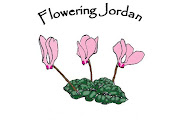One aspect of residing in Jordan that we've come to appreciate is living amongst the ruins of ancient civilizations: some excavated, some in the process of excavation, some buried forever under the foundations of our present civilization. The archaeological, and particularly, the biblical archaeological record of Jordan is very rich.
Several years ago our family had the opportunity to participate in a fascinating archaeological dig just east of the Jordan river and 14 kilometers northeast of the Dead Sea: Dr. Steven Collins, of Trinity Southwest University led an excavation of Tell Al Hammam, believed to be Biblical Sodom. The team returns every year for a month-long season in January/February, and this year, they graciously allowed us to again join them for a day.
Since we joined the dig on a day that two new helpers had arrived from the States, we were privileged to listen to Dr. Collins give his introductory talk about the site from the highest point of Tell Al Hammam, believed to be the palace of this Middle Bronze Age fortification.
The location of Tell Al Hammam and the of the other sites around it, which are located precisely where the cities of the Jordan plains should be, according to the Biblical text, satisfies a major criteria for its designation as Biblical Sodom. To the south and east is Mount Nebo, the traditional site where Moses looked into the Promised Land. It also overlooking the Dead Sea.
To the west, is the Jordan Valley, sites of the cities of the plains, and, through the haze, the land of Canaan, present day Palestine and Israel.
We learned how to "dig" properly. Notice that Dear Husband is using a flat trowel. This is so that he can take the dirt down by levels--think bathwater going down the drain--rather than digging down. The pointed end of the trowel can be used to gently chip away the remains of ancient mud bricks.
Several years ago our family had the opportunity to participate in a fascinating archaeological dig just east of the Jordan river and 14 kilometers northeast of the Dead Sea: Dr. Steven Collins, of Trinity Southwest University led an excavation of Tell Al Hammam, believed to be Biblical Sodom. The team returns every year for a month-long season in January/February, and this year, they graciously allowed us to again join them for a day.
To the west, is the Jordan Valley, sites of the cities of the plains, and, through the haze, the land of Canaan, present day Palestine and Israel.
After a stimulating lecture/briefing, we were invited to help the other archaeologists and dig workers in one of the pits.
Excavation of charred wooden beams
Dr. Collins put Artist son to work cleaning the dirt that he removed from one of the walls.
We learned how to "dig" properly. Notice that Dear Husband is using a flat trowel. This is so that he can take the dirt down by levels--think bathwater going down the drain--rather than digging down. The pointed end of the trowel can be used to gently chip away the remains of ancient mud bricks.
And how to get all that dirt out of the pit? The dig crew fills the "qoufas ", which are then tossed by a strong, able-bodied young man up to another strong, able-bodied young man. The dirt is taken by wheelbarrow to a dumping area.
Getting ready for the toss
The catch
The scene above reminded me of just how enjoyable it can be to dig in the dirt. These men were obviously having a good time, and I easily imagined them as small boys, minus the kneepads and gloves,
I wasn't able to photograph the coolest find of the day: a man, his first hour on the dig (!) unearthed an intact pottery jug from the Middle Bronze Age period. We all congratulated the new digger, but I knew that Dear Husband must have had just a bit of artifact envy. He had been excavating just a couple feet from where the jug was found. Perhaps one of the local workers sensed it too, as he kindly said to Dear Husband, "wijak khair", "your face is good"-- a way of saying that Dear Husband's presence brought good to the dig site.
I asked Dr. Collins wife, herself an accomplished site manager and excavator, how often someone found a piece of pottery like that, in such good condition. Her answer: "Not." We each found various sherds and animal bones which we collected in plastic buckets and mesh bags for later readings. I noticed a smooth rock on the side of the dig wall. I pulled it out and asked Dr. Collins if it was something to keep. Yes, he said, it was a pestle. No, I didn't find the mortar.
There are so many more fascinating things to be told about this site. If you are interested in Biblical archaeology, or archaeology in general, I recommend Dr. Collin's book:
I haven't yet read it, but I plan to purchase it when we are in the US this summer.
Of course, I took a break from digging to do a little wildflower spotting:
Fagonia
JAYA: Just Another Yellow Asteraceae, growing out of ancient ruins, so that makes it unique
Unidentified JAYA
Salvia





















2 comments:
Thanks for sharing your latest adventure. I'm always fascinated by the sights you share here.
~Jenny
How very exciting!/S Susan
Post a Comment